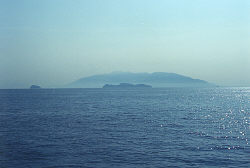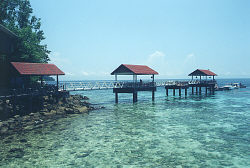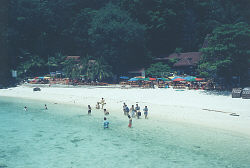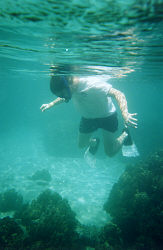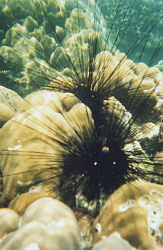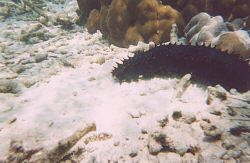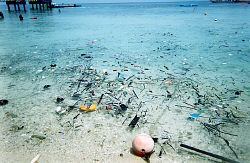Yen's niece is a travel agent and suggested we make a trip to the tiny island of Palau Payar, a popular snorkling spot. It sounded like fun, a scenic boat ride and a half day of snorkling. That morning, Chad got up feeling sick and said he couldn't go. I suggested that he get some breakfast and see how he feels when we get to the dock. An hour later Yen dropped us off at the dock and all is well, so we piled in, along with 50 others.
The ferry is a big passenger-only thing and we grab seats below, but once we cleared the harbor they allowed us to go top side, so that's what we did. As the Georgetown Harbor faded away behind us we hung off the side of the boat with the warm misty air blowing in our faces. Small freighters and fishing boats dotted the waters that were opening up to a wide expanse of sea. As we cruise north, the forested mainland on our right is slowly disappearing in the hazy mist of the tropics. After about an hour we can't see land in any direction anymore. We're at border between the Straight of Malacca and the Andaman Sea.
A little later, a small dot of island appears ahead, and that's Palau Payar. We pull up to a small platform 200 yards off shore, then take turns in a small boat that takes us to the main dock. The ferry is too big to dock closer in. It's a quick walk down the dock to pick up our snorkles and then drop off our stuff at one of the picnic tables on the beach.
I've never been able to find Palau Payar on a map, but it appears to be a green dot maybe a quarter mile across and fifteen miles from the mainland. Thick jungle covers the whole interior with a few rocky beaches showing. Our beach is half the size of a football field at the middle of long crescent. The rocky headlands on either side surround a small reef teeming with fish. The thick jungle and hot muggy air make this far more tropical than Maui, where I was four months earlier. And though it's hot and hazy there's barely a cloud in the sky.
As everyone got changed into their beachwear, colorful patterns begin to appear on the beach. The people on the tour were a real mix. The Chinese were dressed in colorful flower patterns and Hawaiian shirts, the Muslums in simpler colors that blend into the forest background. Some Muslum women stayed in their black frocks all afternoon, content to watch from the beach. There were also a few British, Germans, Indians and Australians.
We waded into the warm water, slipped on our flippers and floated out to the deeper water where the fish were. The sandy bottom turned to coral after about fifty feet, then started getting pretty deep after that. It wasn't exactly the Great Barier Reef, but the variety of coral and fish was a bit more than Maui. Tree and rock coral were all over the bottom making a nice maze to swim through, at ten to fifteen feet deep. Small fish were everywhere and one of the yellow ones bit Chad when he got too close to his little home.
Farther out, big fish started showing up, including gars, morey eels, wrasse, and at the edge of the reef we swam past a 5-foot reef shark. Most interesting of all were the black sea urchins. With 10 inch black spines, fluorescent blue and green hair, and a protruding orange mouth on the top of its head that looked like a big eyeball poking out.
There was a good number of small reef sharks, but it turns out the guide was feeding them. Just after lunch a group of people gathered in a shallow area while the guides were dropping minnows into the mix. A dozen sharks were swimming between peoples legs and the guide said to keep our hands out of the water or the shark might think they're fish. The shark we saw out deeper was bigger, these were two or three feet.
The water was surprisingly clear, something like 20 or 30 feet, clearer than Maui, but not Maui's Molokini Reef. But it wasn't exactly clean. When we first pulled in, we noticed a lot of junk floating on the water a ways off shore, but it wasn't in the snorkeling area. Every so often we'd see old tires on the bottom, boat bumpers that fell off, and even what looked like a dashboard and gearbox. These were pretty rare, but then after lunch the floating junk that we saw earlier came floating into our bay. It was mostly twigs and branches, but it also included small bottles and syringes. There was plenty of it close in, but was clear farther out; and at any rate the swimming was pretty nice below the surface.
About 3:00 we jumped back on the ferry and headed back. This time we stayed below deck where it was quiet - sunburnt, starving, and snoozing most of the way.
Malaysia Travels 2002
Snorkling a remote reef island 30 miles north of Penang

